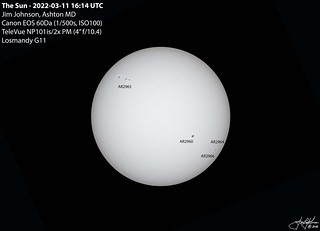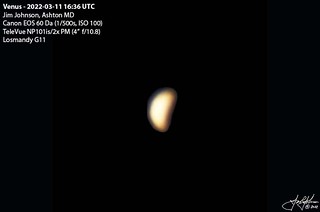What I am happiest about with this session is that the more frequently that I do this the smoother everything goes. I brought the components that I needed out of the cottage, and was imaging in about 15 minutes. After imaging the sun, I moved over to Venus to capture some frames.
The weather was great during the imaging session – about 52 degrees. Surface winds were calm, but seeing was below average. There wasn’t a cloud in the sky.
The NP101 and G11 were already set up. I only needed to remove the tarp before adding the Canon 60Da, and a 2x PowerMate. My working optics were 4” at f/10.8.
I captured the Sun in 100 frames at 1/500s and ISO 100. There was one very large sunspot and just a few others.
After synchronizing on the Sun, I slewed to Venus to see what I could do. The slew completed with Venus nearly centered in the frame. I captured Venus in 50 frames at 1/500s and ISO 100. For this image, the bright sky was the dominant feature on the histogram. I set the peak to about 40%, but I could have moved the peak further to the left. Imaging Venus was more like DSO photography in that I adjusted the exposure based on the sky rather than the object.
Processing was PIPP, AS, RS, and PS. I used 3x dithering for Venus.
I found that Venus was not very well placed for imaging. It was west of the Sun at about 35 degrees elevation. The low elevation was further complicated by below average seeing. Venus is probably very near its greatest elongation, and is receding from earth. In the coming weeks the disk will become more illuminated while the disk becomes smaller. Also, as the Sun progresses along the ecliptic, Venus should be positioned on more highly elevated parts of the ecliptic over the next weeks.


